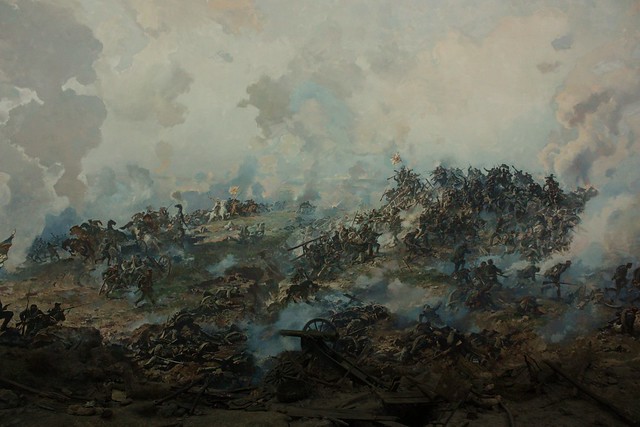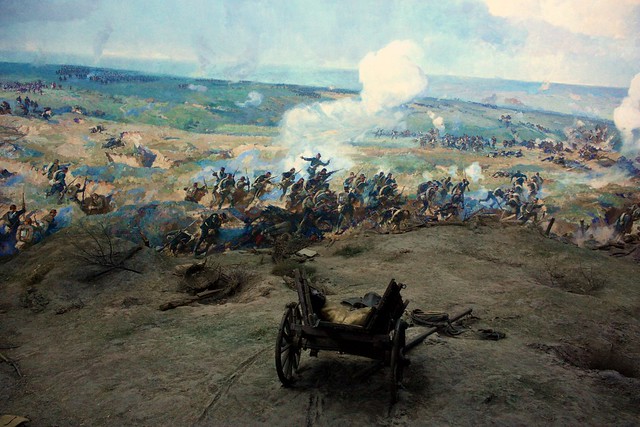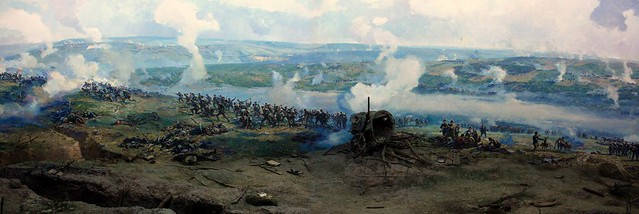

Τον Ιούλιο του 1877, ο Ρωσικός στρατός, κάτω από τις διαταγές του Великий князь Николай Николаевич (Βελίκι κνιάζ Νικολάι Νικολάεβιτς - Μέγα Δούκα Νικολάου), κινήθηκε προς τον ποταμό Δούναβη, χωρίς ιδιαίτερη αντίσταση, καθώς οι Τούρκοι δεν είχαν ιδιαίτερα μεγάλο στρατό στην περιοχή... Η Υψηλή Πύλη έστειλε στην περιοχή στρατιωτικές δυνάμεις κάτω από την διοίκηση του ευφυή στρατηγού Osman Nuri Paşa (Οσμάν Νουρί Πασά) για να ενισχύσουν την άμυνα της πόλης Никопол (Νικοπόλ - Νικόπολις). Η πόλη, όμως, είχε καταληφθεί στην Μάχη της Νικόπολις στις 16 Ιουλίου του 1877, πολύ πριν φτάσει ο τουρκικός στρατός εκεί.

Ο Οσμάν πασάς αποφάσισε τότε να οργανώνει την άμυνα της πόλης Плевен (Πλέβεν), τότε, στα Τουρκικά, Plevne, φτιάχνοντας έναν μεγάλο αριθμό οχυρωματικών έργων...
Η πρώτη μάχη...

Στις 19 Ιουλίου έφτασε κοντά στην πόλη η 5η Μεραρχία της 9ης Ρωσικής Στρατιάς με τον διοικητή της στρατηγό Юрий Иванович Шильдер-Шульдне (Γιούρι Ιβάνοβιτς Σίλντερ-Σούλντνε). Ο στρατηγός διέταξε την πρώτη μέρα να βομβαρδίσουν την πόλη και την δεύτερη μέρα διέταξε επίθεση και κατάφερε να καταλάβει διάφορες οχυρωματικές θέσεις. των Τούρκων.. Ο Οσμάν πασάς με μία σειρά αντεπιθέσεων κατάφερε να ανακαταλάβει τις θέσεις αυτές προκαλώντας απώλειες 2.800 στρατιωτών στους Ρώσους έναντι 2.000 των Τούρκων...
Η δεύτερη μάχη...

Ο Οσμάν πασάς ενίσχυσε την άμυνα της πόλης και έφτιαξε περισσότερα οχυρωματικά έργα την στιγμή που οι Ρώσοι ζήτησαν και έλαβαν ενισχύσεις από τον πρίγκηπα Κάρολο της Ρουμανίας, ο οποίος, όμως, απαίτησε να είναι επικεφαλής της κοινής Ρωσο-Ρουμανικής δύναμης... Παράλληλα, στην περιοχή έφτασε ο στρατηγός Николай Павлович Криденер (Νικολάι Πάβλοβιτς Κρίντενερ) με την υπόλοιπη 9η Ρωσική στρατιά, ενώ στο μεταξύ ο στρατός του Οσμάν πασά δέχτηκε ενισχύσεις και έφτασε τις 20.000. Στις 31 Ιουλίου το Ρωσικό επιτελείο διέταξε τον Κρίντενερ να επιτεθεί στην πόλη. Η επίθεση έγινε σε τρία μέτωπα... Στα βόρεια επιτέθηκε η μεραρχία πεζικού του διάσημου Ρώσου στρατηγού Михаил Дмитриевич Скобелев (Μιχαήλ Ντιμίτρεβιτς Σκομπέλεβ), γνωστού και ως ο "Λευκός Στρατηγός", γιατί ήταν πάντοτε ντυμένος στα λευκά πάνω σε λευκό άλογο...

Οι Ρώσοι κατάφεραν να καταλάβουν κάποια οχυρωματικά έργα, αλλά μέχρι το τέλος της ημέρας, οι Τούρκοι κατάφεραν να ανακόψουν τις επιθέσεις και να ανακαταλάβουν το χαμένο έδαφος... Οι απώλειες των Ρώσων κατά την δεύτερη μάχη ήταν 7.300, ενώ των Τούρκων μόλις 2.000...
Η τρίτη μάχη...

Ο Οσμάν πασάς δεν εκμεταλεύτηκε το πλεονέκτημα που κέρδισε από τις δύο πρώτες μάχες, για να εκδιώξει τον Ρωσικό στρατό. Έκανε, πάντως, μία εξόρμηση ιππικου, η οποία στοίχησε σε αυτόν 1.000 άνδρες και στους Ρώσους 1.300. Οι Ρώσοι συνέχισαν να στέλνουν ενισχύσεις στο Πλέβεν και ο στρατός τους έφτασε τους 100.000 άντρες κάτω από την διοίκηση, πλέον, του ίδιου του Μέγα Δούκα... Στις 1 Σεπτεμβρίου του 1877, ο στρατηγός Σκομπέλεβ με 20.000 άντρες επιτέθηκε στην πόλη Ловеч (Λόβετς), τότε στα Τουρκικά Lofça, στην οποία ο Οσμάν είχε τοποθετήσει τουρκική φρουρά 15 ταγμάτων για να προστατεύει την γραμμή ανεφοδιασμού του Πλέβεν... Ο Οσμάν με μέρος της φρουράς του Πλέβεν προέλασε προς το Λόβετς, αλλά, στις 3 Σεπτεμβρίου, πριν προλάβει να φτάσει στην πόλη, ο Σκομπέλεβ την είχε ήδη καταλάβει... Οι Τούρκοι επιζώντες έφτασαν στο Πλέβεν, όπου ενίσχυσαν την φρουρά του, οργανωμένοι σε τρία τάγματα...

Η κατάληψη της Γκριβίτσα (Wikipedia)
Στις 11 Σεπτεμβρίου οι Ρώσοι πραγματοποίησαν μίας μεγάλης έκτασης επιχείρηση εναντίων του Πλέβεν. Ο στρατηγός Σκομπέλεβ κατέλαβε δύο οχυρωματικές θέσεις στα ανατολικά, ενώ οι Ρουμάνοι την θέση στο χωριό Гривица (Γκριβίτσα) στα βόρεια της πόλης... Την επόμενη μέρα οι Τούρκοι ανακατέλαβαν τις ανατολικές θέσεις αλλά δεν ήρθαν σε σύγκρουση με τους Ρουμάνους...
Από την αρχή του Σεπτεμβρίου του 1877, οι Ρώσοι έχασαν κοντά στους 20.000 άντρες, ενώ οι Τούρκοι γύρω στους 5.000.
Η τέταρτη μάχη...
Οι τεράστιες απώλειες των Ρώσων τους ανάγκασαν να σταματήσουν τις κατά μέτωπον επιθέσεις... Στην περιοχή ήρθε ο στατηγός Eduard Totleben, ως επικεφαλής του Ρωσικού επιτελείου, ο οποίος αποφάσισε τον αποκλεισμό της πόλης... Μέχρι τις 24 Οκτωβρίου η πόλη του Πλέβεν είχε περικυκλωθεί...

Ο Οσμάν ζήτησε από την Υψηλή Πύλη να εγκαταλείψει το Πλέβεν και να υποχωρήσει, αλλά η απάντηση ήταν αρνητική... Οι προμήθειες του Τουρκικού στρατού άρχισαν να στερεύουν και στις 9 Δεκεμβρίου ο Οσμάν έκανε μία προσπάθεια με έξοδο μέσα στην νύχτα να περάσει το ποτάμι Вит (Βιτ) και να σπάσει την Ρωσική πολιορκία... Η μάχη ήταν πολύ σκληρή, σώμα με σώμα, αλλά οι αναλογία των Ρωσικών δυνάμεων ήταν 5 προς 1 και κατάφεραν να απωθήσουν τους Τούρκους πίσω στο Πλέβεν... Στην μάχη τραυματίστηκε και ο Οσμάν πασάς από μια σφαίρα, η οποία διαπέρασε το πόδι του και σκότωσε το άλογο του... Η φήμη ότι ο πασάς σκοτώθηκε προκάλεσε πανικό στους Τούρκους.. Οι απώλειες των Τούρκων ήταν 5.000 έναντι 2.000 των Ρώσων... Την επόμενη μέρα ο Οσμάν πασάς παρέδωσε την πόλη και έδωσε το ξίφος του στον Ρουμάνο συνταγματάρχη Mihail Cerchez... Οι Ρώσοι φέρθηκαν στον πασά καλά και ως ένδειξη τιμής του επέτρεψαν να κρατήσει το ξίφος του... Από τους 40.000 Τούρκους αιχμαλώτες πολλοί έχασαν στην συνέχεια την ζωή τους από το κρύο και την πείνα...
Οι Ρωσικές δυνάμεις που έγιναν διαθέσιμες μετά την νίκη στο Πλέβεν κατευθύνθηκαν στο πέρασμα της Σίπκα, όπου βοήθησαν και εκεί στην νίκη επί των Τούρκων...
 Οι φωτογραφίες είναι από το ξακουστό Πανόραμα «Το έπος του Πλέβεν του 1877», ένα μοναδικό μνημείο χτισμένο στην πόλη του Πλέβεν και αναφέρονται στα γεγονότα της τρίτης μάχης...
Οι φωτογραφίες είναι από το ξακουστό Πανόραμα «Το έπος του Πλέβεν του 1877», ένα μοναδικό μνημείο χτισμένο στην πόλη του Πλέβεν και αναφέρονται στα γεγονότα της τρίτης μάχης...[ENG] From Wikipedia: The Siege of Pleven - In July 1877, the Russian Army, under the command of Grand Duke Nicholas, moved toward the Danube River virtually unopposed, since the Turks had no sizable force in the area. The Turkish high command sent an army to reinforce the city of Nikopol under the command of Osman Pasha. Before Osman reached Nikopol, the Russian vanguard easily took the city in the Battle of Nikopol (16 July 1877) and Osman settled on Pleven, a town among vineyards in a deep rocky valley some twenty miles to the south of Nikopol. He created a strong military fortress, raising earthworks with redoubts, digging trenches and quarrying out gun emplacements. From Pleven Osman's army dominated the main strategic routes into the heart of Bulgaria. Hours after Osman constructed fortifications, Russian forces began to arrive. First Battle: General Schilder Schuldner, commanding the Russian 5th Division, IX Corps, received orders to simply occupy Pleven. Schuldner arrived outside the city on July 19 and began to bombard the Turkish defenses but made no attack. The next day, Schuldner attacked and succeeded in driving the Turks from some of the outer defenses. Osman pasa brought up reinforcements and launched a series of counter-attacks which drove the Russians from the captured trenches, inflicting 2,800 casualties at a cost of 2,000. Second Battle: Osman Pasha strengthened his defences and built more redoubts while the Russians sought and obtained reinforcements from the army of Prince Charles of Romania, who made the condition that he should be given command of the joint besieging force. General Nikolai Kridener arrived with the entire Russian IX Corps and Osman's forces grew to 20,000. On July 31, Russian headquarters ordered Kridener to assault the city, which took place from three sides , with every expectation of a Russo-Romanian triumph. Kridener had a cavalry division under General Schakofsky and an infantry division under General Mikhail Skobelev. Schakofsky attacked the eastern redoubts and Skobelev assailed the Grivitsa redoubt to the north. Schakofsky managed to take two redoubts, but by the end of the day, the Turks succeeded in repulsing all the attacks and retaking lost ground. Russian losses amounted to 7,300 and the Turks lost 2,000. Third Battle: After repulsing the Russian attacks, Osman failed to press his advantage and possibly to drive off the besiegers. He did however make a cavalry sortie on August 31 that cost the Russian 1,300 casualties and the Turks 1,000. The Russians continued to send reinforcements to Pleven, and their army reached 100,000 men, now personally led by the Grand Duke. On September 3, Skobelev reduced the garrison at Lovech guarding the Turkish supply-lines before Osman could move out to relieve it. The Turks organized the survivors of Lovech into 3 battalions for the Pleven defenses. Osman received an additional 13 battalions, bringing his total strength to 30,000; the highest it would reach during the siege. On September 11, the Russians made a large-scale assault on Pleven. Skobelev took two southern redoubts and a Romanian division took the Grivitsa redoubt. The next day the Turks retook the southern redoubts, but could not dislodge the Romanians. From the beginning of September, Russian losses had amounted to roughly 20,000, while the Turks lost 5,000. Fourth Battle: Growing Russian casualties put a halt to frontal assaults. General Eduard Ivanovich Todleben arrived to oversee the conduct of the siege as the army chief of staff. Todleben had proved command experience in siege warfare: he had previously gained renown for his defense of Sevastopol (1854 - 1855) during the Crimean War. He decided on a complete encirclement of the city and of its defenders and by October 24 the Russians and Romanians had completely surrounded Pleven. Osman requested permission to abandon Pleven and retreat, but the Ottoman high command did not allow him to do so. Supplies began to run low in the city and Osman finally made an attempt to break the Russian siege in the direction of Opanets. On December 9, the Turks silently emerged, at dead of night, threw bridges over and crossed the Vit River, attacked on a 2-mile front and broke through the first line of Russian trenches. Here they fought hand to hand and bayonet to bayonet, with little advantage to either side. Outnumbering the Turks almost 5 to 1, the Russians drove the Turks back across the Vit and wounded Osman in the process. Osman Pasha was wounded in the leg by a stray bullet, which killed his horse beneath him. Rumors of his own death created panic. Making a brief stand, the Turks eventually found themselves driven back into the city, losing 5,000 men to the Russians' 2,000. The next day, Osman surrendered the city, the garrison and his sword to the Romanian colonel Mihail Cerchez. He was treated honorably, but his troops perished in the snows by the thousand as they straggled off into captivity. Note: The photos are from the Pleven Panorama, otherwise known as "Pleven Epopee 1877" and represent mainly the events of the thrid battle...
[BUL] Обсада на Плевен.








1 comment:
Καταπληκτική ανάρτηση, Κλέαρχε, έμεινα έκθαμβη...Πανέμορφα όλα...
Μπράβο σου...
Φιλιά πολλά απο ΝΖ...
Post a Comment